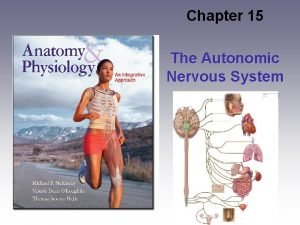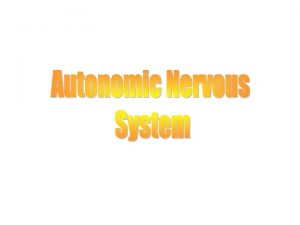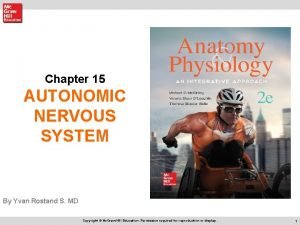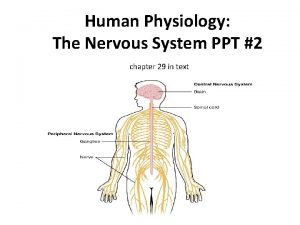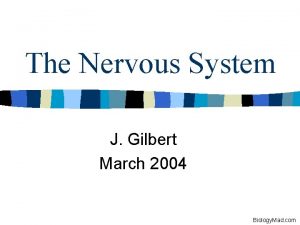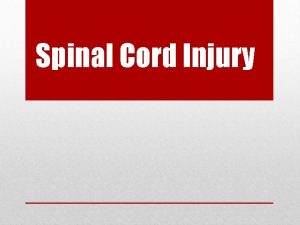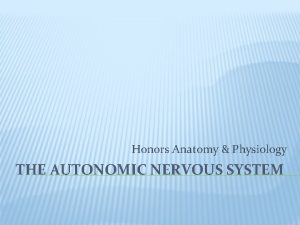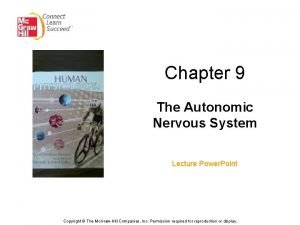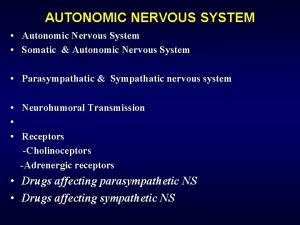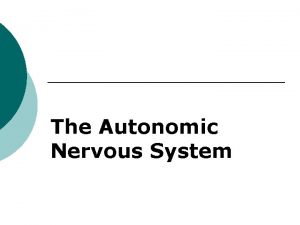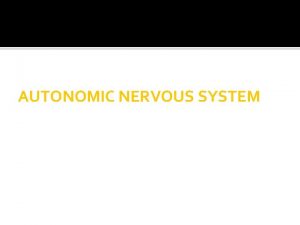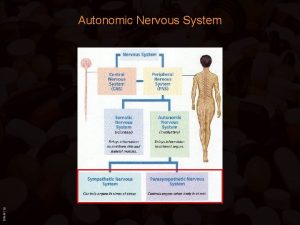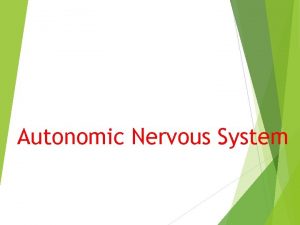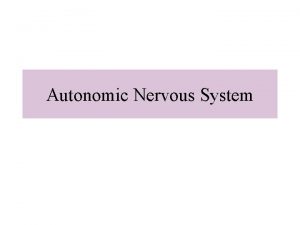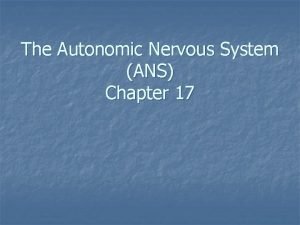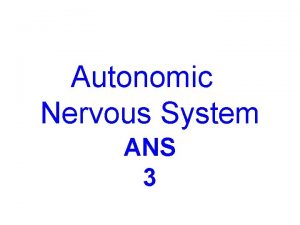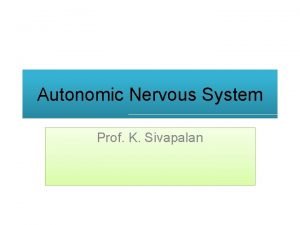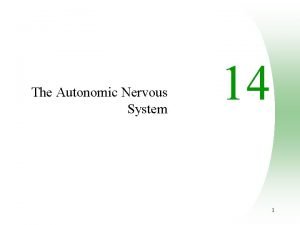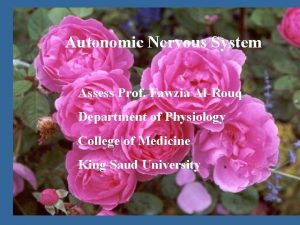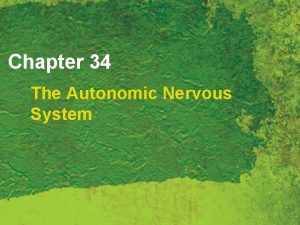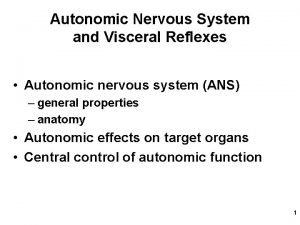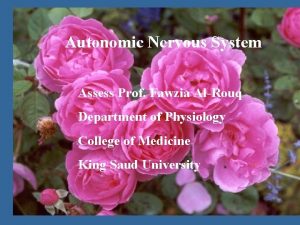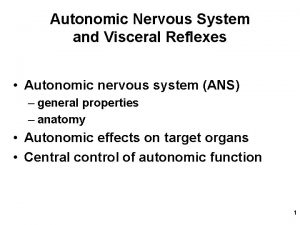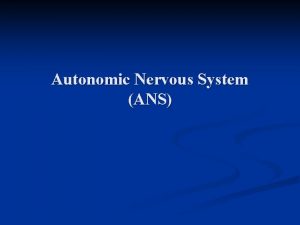Human Anatomy The Autonomic Nervous System ANS ANS
























- Slides: 24

Human Anatomy The Autonomic Nervous System ANS

ANS • 1. 2. 3. 4. 5. Regulates various physiological processes unconsciously, for instance: Cardiovascular Respiration Digestion Body temperature Excretion

2 Subdivisions of the ANS 1. • 2. • Sympathetic NS “fight or flight” Parasympathetic NS “rest and repose”

Anatomy of ANS • 1. 2. • • Consists of only 2 neurons Preganglionic neuron (#1) Ganglionic neuron (#2) The ganglion is a structure where the axon of the preganglionic neuron synapses (release of neurotransmitter) with the ganglionic neuron (dendrite or cell body) The axon of the ganglion synapses with the target cell or organ.

Anatomy of the ANS • 1. 2. 3. 4. Differences between sympathetic and parasympathetic are: Location of preganglionic (#1) cell body Location of the ganglia Neurotransmitters released at synapses Effects on target organs

Sympathetic Anatomy • Once again, just 2 cells • Preganglion (#1) cell body in gray matter of spinal cord ---- levels T 1 – L 2 • Thoracolumbar system

Sympathetic Anatomy Thoracolumbar

Sympathetic Anatomy • Synapse of preganglionic (#1) with ganglionic (#2) neurons happens in the ganglion • 3 cervical ganglia • 3 abdominal ganglia • Neurotransmitter is acetylcholine (ACh)

Sympathetic Anatomy Thoracolumbar

Sympathetic Ganglia • 1. • • • 2. • • • Paravertebral ganglia Cervical Superior Middle Inferior Abdominal Celiac Superior mesenteric Inferior mesenteric

Sympathetic Anatomy Thoracolumbar

Sympathetic Anatomy • Ganglionic (#2) axons are relatively long • Synapse at target cell or organ • Neurotransmitter is norepinephrine (NE)

Sympathetic Anatomy Thoracolumbar

Parasympathetic Anatomy • • 1. 2. • Once again, just 2 cells Preganglionic (#1) cell body in either: Brainstem Spinal cord ---- S 2 – S 4 Craniosacral system

Parasympathetic Anatomy Craniosacral

Parasympathetic Anatomy • Synapse of preganglionic with ganglionic neurons happens in the ganglion • Ganglia are located on the target organs

Parasympathetic Anatomy Craniosacral

Parasympathetic Anatomy • Ganglionic axons are relatively short • Synapse at target cell or organ • Neurotransmitter is acetylcholine (ACh)

Parasympathetic Anatomy Craniosacral

Summary FIGURE 17 -2 p. 445

Summary • 1. 2. 3. Sympathetic • Thoracolumbar 1. Paravertebral ganglia 2. ACh then NE 3. Parasympathetic Craniosacral Ganglia at target ACh and ACh

Biological Effects • Most organs have dual innervation 1. CV • S – increase heart rate, force of ventricle contraction, increase blood pressure by constricting smooth muscles of arteries • P -- opposite

Biological Effects 2. Respiration • S – dilation of bronchiole smooth muscle which increases diameter • P – opposite 3. Digestion • S – decreases activity of organs and glands • P -- opposite

Biological Effects 4. • • 5. • • Vision S – dilation of pupil P – constriction of pupil Reprodction S – causes ejaculation in males P – sexual arousal (erection) in both sexes
 Alpha 1 receptors
Alpha 1 receptors Somatic motor neuron
Somatic motor neuron Autonomic nervous system consists of
Autonomic nervous system consists of Autonomic receptors
Autonomic receptors Ganglion on spine
Ganglion on spine Autonomic nervous system
Autonomic nervous system The autonomic nervous system controls
The autonomic nervous system controls Visceral nervous system
Visceral nervous system Autonomic nervous system
Autonomic nervous system Chart of nervous system
Chart of nervous system Identify each type of neuronal pool
Identify each type of neuronal pool Nervous
Nervous Fundamentals of the nervous system and nervous tissue
Fundamentals of the nervous system and nervous tissue Autonomic nerveous system
Autonomic nerveous system Human nervous system ppt
Human nervous system ppt The human nervous system biology mad
The human nervous system biology mad Nervous system and digestive system
Nervous system and digestive system Endocrine system and nervous system
Endocrine system and nervous system Endo crine gland
Endo crine gland Endocrine system
Endocrine system Anal wink reflex
Anal wink reflex Autonomic reflex arc
Autonomic reflex arc Autonomic vs somatic
Autonomic vs somatic Autonomic network management
Autonomic network management An architectural blueprint for autonomic computing
An architectural blueprint for autonomic computing





